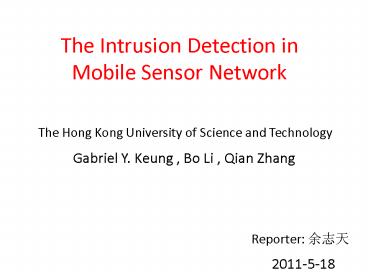The Intrusion Detection in Mobile Sensor Network - PowerPoint PPT Presentation
1 / 30
Title:
The Intrusion Detection in Mobile Sensor Network
Description:
The Intrusion Detection in Mobile Sensor Network. Gabriel Y. Keung , Bo Li , Qian Zhang. The Hong Kong University of Science and Technology. Reporter: – PowerPoint PPT presentation
Number of Views:125
Avg rating:3.0/5.0
Title: The Intrusion Detection in Mobile Sensor Network
1
The Intrusion Detection in Mobile Sensor Network
The Hong Kong University of Science and Technology
- Gabriel Y. Keung , Bo Li , Qian Zhang
Reporter ???
2011-5-18
2
Outline
- Introduction
- Network and Mobility Model
- The Intrusion Detection Problem in a MSN
- Sensitivity Analysis
- Simulation
- Conclusions Further Research
3
Outline
- Introduction
- Network and Mobility Model
- The Intrusion Detection Problem in a MSN
- Sensitivity Analysis
- Simulation
- Conclusions Further Research
4
Wireless Sensor Network(WSN)
- Consists of sensors for monitoring
- Temperature
- Vibration
- Pressure
- Motion
- Pollutants
- Cooperatively pass their data through the network
to a main location.
- Each sensor is connected to one or several
sensors - a radio transceiver
- a microcontroller
- an electronic circuit for interfacing with the
sensors - an energy source.
5
Intrusion Detection in stationary WSN
Sensors and Cameras
- Detecting ground vibrations from foot steps and
identifying warm body movement.
Mexican Side
- The operation of American Border Patrol
- places sensors along the American/Mexican borders
(virtual fence")
US Side
6
k-Barrier Coverage(k-????)
- Barrier coverage
- treat sensor as barrier
- coverage be detected by a sensor
- Detect any intruders along any paths by at
least k distinct sensors - A very important concept for intrusion detection
sensitivity analyze
7
Mobility Sensor Network(MSN)
- In stationary WSN
- sensors remain stationary after the initial
deployment - barrier coverage is determined by the initial
network configuration and sensor deployment - vacuum zone
- In MSN
- sensors can be relocated after deployment
- a better barrier coverage
8
The objectives of this paper
- characterize the k-barrier coverage
- compute probability of k-barrier coverage
- investigate the probability of k-barrier coverage
sensitivity under different parameters - examine the average travel distance
9
Outline
- Introduction
- Network and Mobility Model
- The Intrusion Detection Problem in a MSN
- Sensitivity Analysis
- Simulation
- Conclusions Further Research
10
The Kinetic Theory of Gas Molecules
- air molecule ? mobile sensor
- electron ? intruder
- The mean free path
- free pathAB,AC
- The average travel distance
- derived from kinetic theory(the mean free path)
- compute the probability of k-barrier coverage
performance
B
A
C
11
Scenario
- A a long and narrow belt-like region
- N(A) the number of mobile sensors
- A the area of the region W the width of the
area A/W the length - nA the density of mobile sensors nAN(A)/A
- Rsensing range
- the sensor location can be modeled by a
stationary two-dimensional Poisson process .
12
Mobility Model
- Sensors move independently
- Random direction mobility model
- Randomly chooses a direction ? ?0 2p ) with
probability density function PT(?) - Randomly chooses a speed from a range vm
?0,vmax, with probability density function
PVm(vm) - Once the boundary is reached, the sensor bounds
back, by choosing another angular direction and
continues the process. - Intruder movement is crossing from one parallel
boundary to another - vi the velocity of an intruder
13
Coverage Measurement
- k-barrier coverage for an intruder traveling path
- k-barrier coverage for a mobile sensor network
- ? the cumulative coverage count by mobile
sensors for any intruder paths - Pr(?k) probability that a MSN satisfies this
k-barrier coverage definition - uncovered distance
- coverage rate (T\ Ts\ Tv) number of sensor
coverage per unit time
14
Outline
- Introduction
- Network and Mobility Model
- The Intrusion Detection Problem in a MSN
- Sensitivity Analysis
- Simulation
- Conclusions Further Research
15
What we need?
- Goal Pr(?k)
- Kinetic theory of gas molecules
- average travel distance
- ? average uncovered distance
- Pr(?k) can be achieved by formulating the
uncovered distance(?) and sensor coverage
rate(Ts)
16
First assume sensors are stationary
- cross section of coverage
- the number of sensor coverage
- nAA Ts t
- average uncovered distance ?
- travel distance of an intruder divided by the
number of sensor coverage
17
In mobile sensor network
- Relative speed vrel
- The coverage rate can be obtained by
18
The k-Barrier Coverage in an MSN
- Probability of k-barrier coverage in an MSN
19
- Average relative speed
- Expected total number of sensor coverage
20
Uncovered Distance Distribution
- the number of uncovered intruders t 0, N0 at
time t, N - during dt, the NTvdt intruders will be covered
- l uncovered distance for the length vit
21
Result Formulas
22
Outline
- Introduction
- Network and Mobility Model
- The Intrusion Detection Problem in a MSN
- Sensitivity Analysis
- Simulation
- Conclusions Further Research
23
Sensitivity analysis
- Density of Sensors and k-barrier Coverage
Probability(nA , Pr(?k)) - Simplify the equations for analysis
- vi vm
- A50100, R1
24
Sensitivity analysis
- In a hybrid sensor network
- mobile static ?
25
Sensitivity analysis
- Sensor Speed and k-barrier Coverage Probability
- vm vi
26
Outline
- Introduction
- Network and Mobility Model
- The Intrusion Detection Problem in a MSN
- Sensitivity Analysis
- Simulation
- Conclusions Further Research
27
Simulation
28
Outline
- Introduction
- Network and Mobility Model
- The Intrusion Detection Problem in a MSN
- Sensitivity Analysis
- Simulation
- Conclusions Further Research
29
Conclusions Further Research
- Mobility can be exploited to obtain better
barrier coverage - Further Research
- detection error under varying sensor speeds
- study the optimal patrol route of controlled
mobile sensors
30
- Thank You!
- Any questions?
Yu Zhitian
2011-5-18































